

Matt Campbell
2025 Porsche 911 Carrera T review
5 Days Ago
Does the buck-banging end of Mazda’s compact SUV range still maintain its shine despite its advancing age?
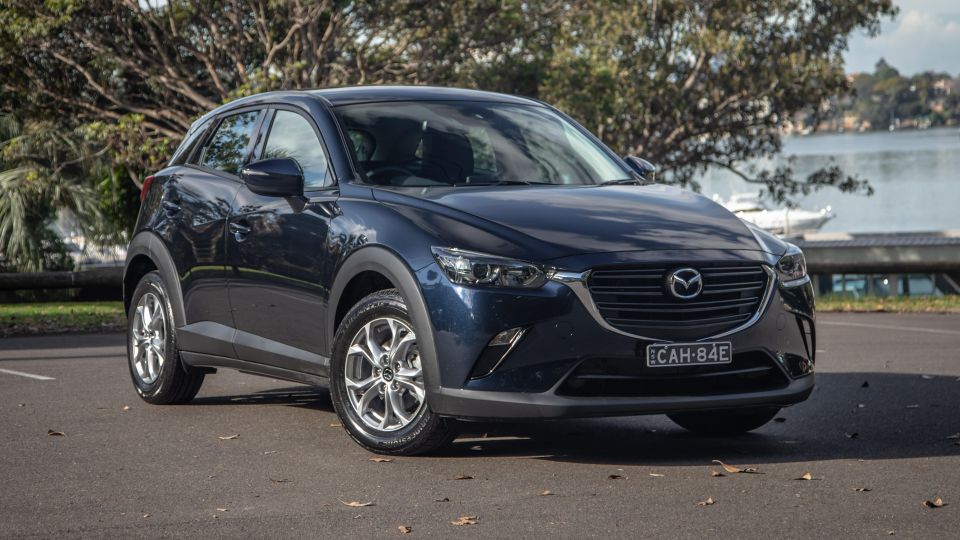


Journalist
New from
$22,890
excl. on-roads

Journalist
New from
$22,890
excl. on-roads


Journalist
New from
$22,890
excl. on-roads

Journalist
New from
$22,890
excl. on-roads
Quickly see how this car stacks up against its competition. Select any benchmark to see more details.
Where expert car reviews meet expert car buying – CarExpert gives you trusted advice, personalised service and real savings on your next new car.
The Mazda CX-3’s has been so popular over the past six years of local sale, and its appearance on the road is so common, that they’ve almost become invisible out of sheer familiarity.
It’s long been a smart looker, subtly more so after 2018’s mild facelift, but they certainly go unnoticed in a way that, well, Mazda’s newer CX-30 doesn’t. Are the CX-3’s days numbered, the newcomer poised to knock the stalwart into the retirement’s pasture? Not necessarily. Not yet.
As seductive as the ‘30’ might be, you’ll still need around $33,000 as a kick-off to park the larger of Mazda’s pint-sized SUVs in your driveway and the nicer version head north from there. Meanwhile, the ‘3’ earns valuable keep luring thriftier budgets, driven away for as little as $25,000.

That’s right, one key CX-3 role is representing a cost-effective access points into light SUV ownership, holding off the fresh-faced competition from the likes of Hyundai Venue and Kia Stonic. But it also scales upmarket, taking on relative newcomers such as new Ford Puma and Toyota Yaris Cross. A broad if aging range for what’s long been a popular choice in segment.
Though not the cheapest CX-3 option, the one-up-from-base Maxx Sport front-driver automatic on test here could be viewed as the most pragmatic temptation in the current, recently fettled line-up. Dodging the base-model doldrums and appearing solid value for money, our test subject probably best represents the little Mazda’s key appeal.
Is this version the deftly balanced blend of niceties, smarts and swagger worthy of your attention this far into its lifecycle? Let’s find out.
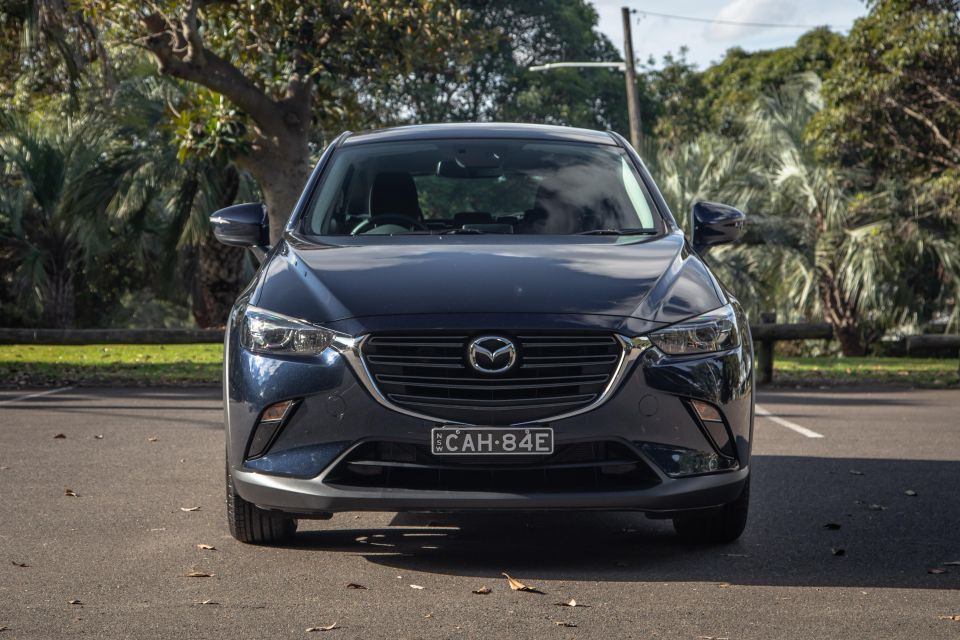
The Maxx Sport FWD lists for $24,890 as a six-speed manual, with a $2000 premium for an example fitted with a six-speed automatic transmission as tested here.
That works out to $27,990 (6MT) and $29,000 (6AT) drive-away as offered on Mazda’s public website.
Fancy all-wheel drive? That lists the outlay a couple of grand further up the fiscal tree, to $31,990 drive-away, in a version that’s only offered as an automatic.
In front-wheel drive, there are another four variants that push the CX-3 concept further upmarket depending on buyer tastes, preferences and budget… unless you fancy a diesel, a largely unpopular option that has recently dropped off the menu.
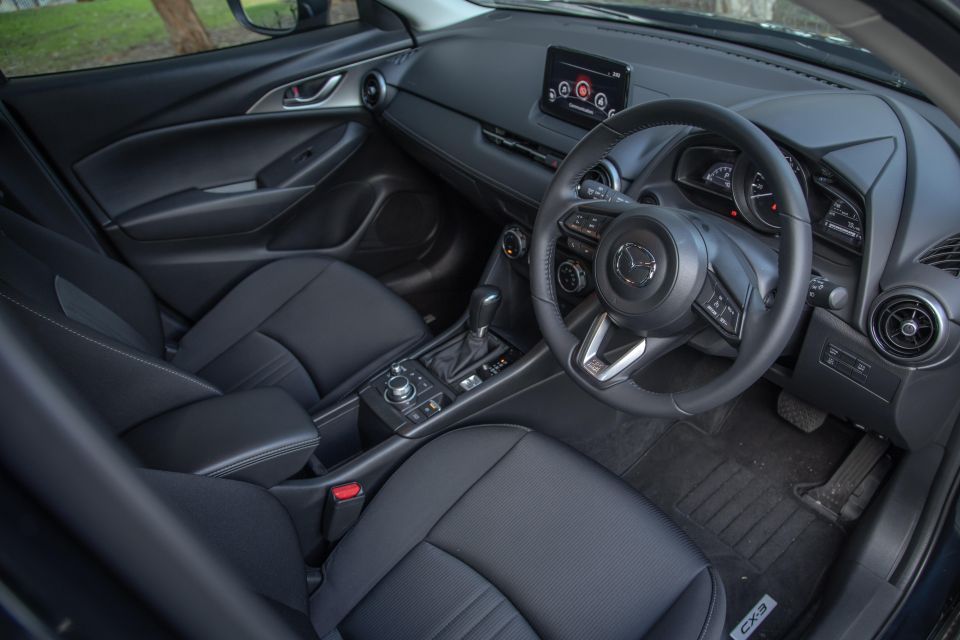
The competitive set includes many rivals that line-up against the the slightly fancier CX-3 Maxx Sport LE reviewed here, including usual suspects such as the Hyundai Venue Elite ($26,740), Kia Stonic Sport auto ($26,490 drive-away), Nissan Juke ST ($27,990), Renault Captur Life ($28,190), Skoda Kamiq 85TSI ($26,990), Toyota Yaris Cross GX FWD ($26,990) and Volkswagen T-Cross 85TSI Life ($28,390).
The CX-3 Maxx Sport auto’s circa-$27k list price also opens up plenty of larger options with ground-floor versions of Honda HR-V, Hyundai Kona, Kia Seltos, Mitsubishi ASX, Nissan Qashqai and Subaru XV all offered for similar ballpark outlay. And Mazda’s own CX-30 Pure, at $28,990 list, isn’t realistically a huge stretch.
Big competition, then, from an awful lot of angles. A situation made more complex for the buyer given pricing – particularly drive-away pricing – is so very volatile in this band of the new car market and special offers are quite commonplace.
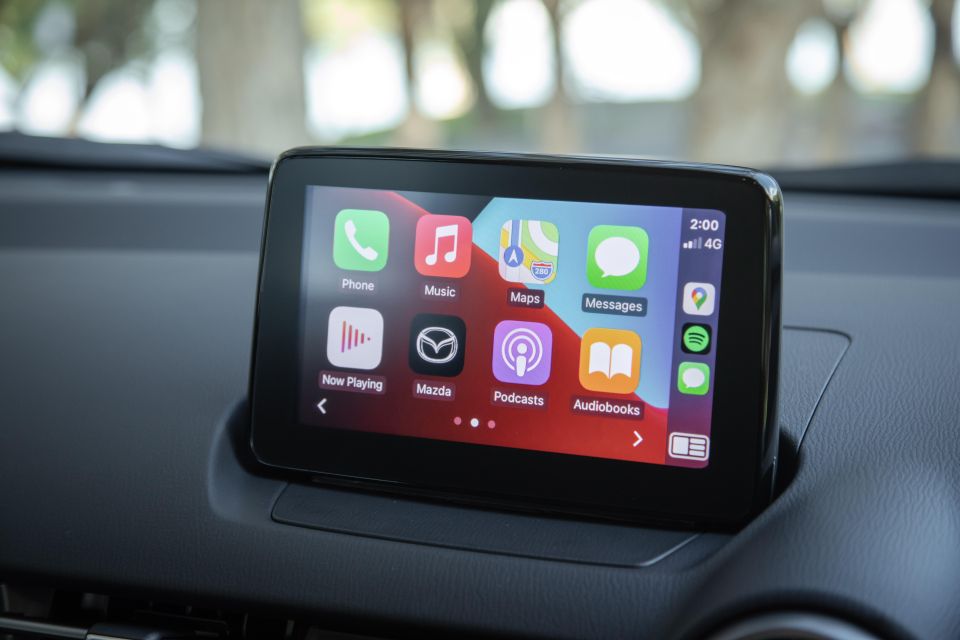
The CX-3 Maxx Sport gets a reasonably healthy array of standard equipment that includes:
The CX-3 comes in a choice of eight different colours, many of them metallic and mica effect for no added cost. Special finishes such as Soul Red, Machine Grey and Polymetal Grey all carry a $495 upcharge. There’s also an option of two alternative alloy wheel styles for $365 total per set and Kuroi Sports Pack body enhancement for around $2870.
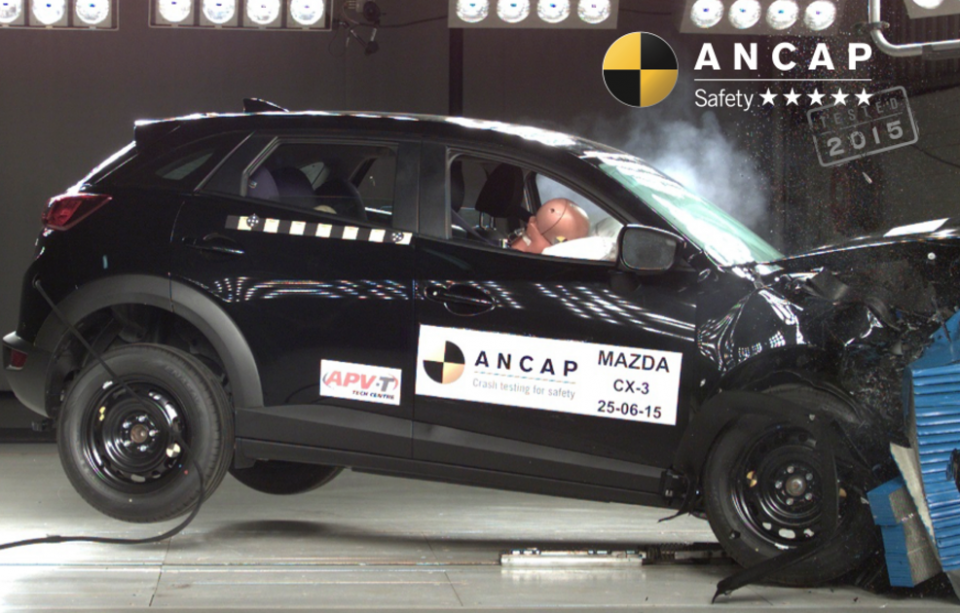
The CX-3 range has a five-star ANCAP rating based on assessment conducted back in 2015. It scored a commendable 36.44 out of 37 with excellent results for frontal offset (15.44 out of 16), side impact (16 out of 16) and Good ratings for whiplash and pedestrian protection.
Although all variants carry the same rating, they’re not all specified equally. For its part, the Maxx Sport fits autonomous emergency braking (up to 80km/h) with daytime and night-time pedestrian detection as well as blind-spot monitoring and rear cross-traffic alert, though it misses out on adaptive cruise control, lane departure warning and traffic sign recognition found further up the CX-3 range.
It does, though, feature auto headlights and an auto-dimming mirror, as well as front, side and side curtain airbags.
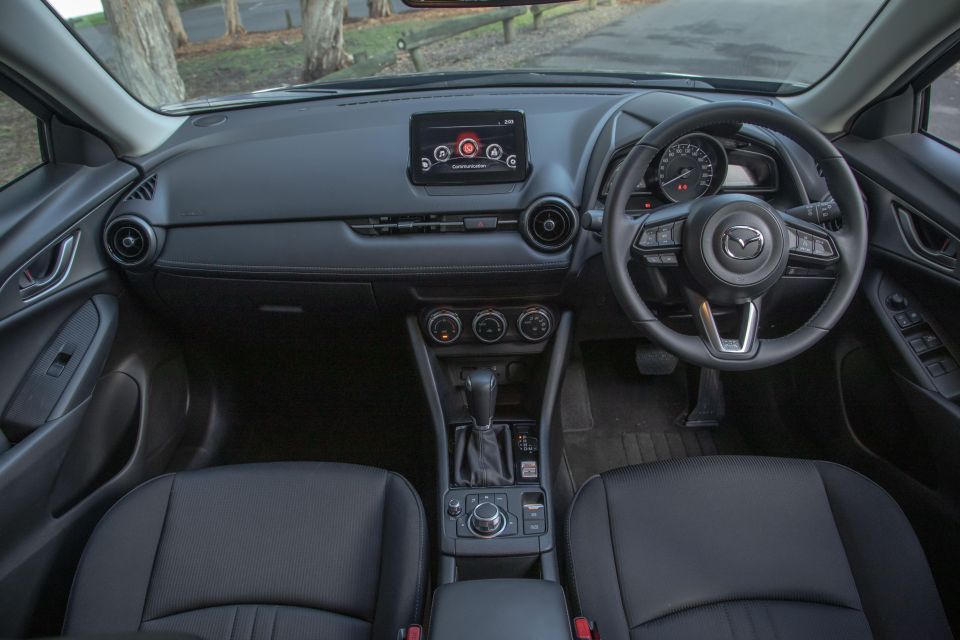
When the CX-3 arrived half a dozen years back, its stylised cabin design brought a pleasingly sporty and somewhat mature theme to a segment where blandness wasn’t uncommon. Fast forward and not much of it has changed save for a light touch-up four years ago, so it’s understandable that the little Mazda’s cabin doesn’t quite retain the charm that it once did for a lack of freshness.
Compared to the many more contemporary designs Mazda has rolled out in ranges elsewhere, the CX-3 is starting to feel a little old-hat. And the fairly rudimentary Maxx Sport fit-out doesn’t do much to inject a sense of celebration, bar the neat MX-5-like steering wheel.
There’s a lot of basic cloth and acres of shiny and hardy plastic – as we’ve noted in reviews past, these are not strange for mostly-sized SUVs and crossovers plugging into this price point. It’s just that, despite some of the adventure in the surface styling and the still neat central roundel instrumentation format, the cabin space is fairly bland and somewhat featureless.
You do get that MZD rotary controller array – once Mazda’s little upmarket trick to separate its cabin from the unwashed pack – and it’s paired with an updated infotainment system, pegged as one of CX-3’s new MY21 highlights as it now adopts wired Apple CarPlay and Android Auto as standard.
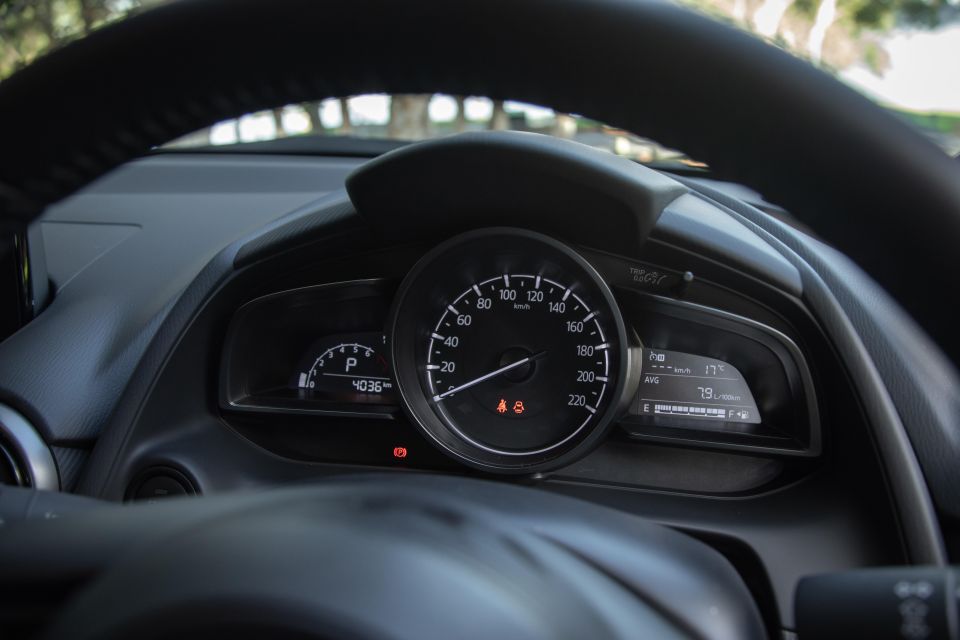
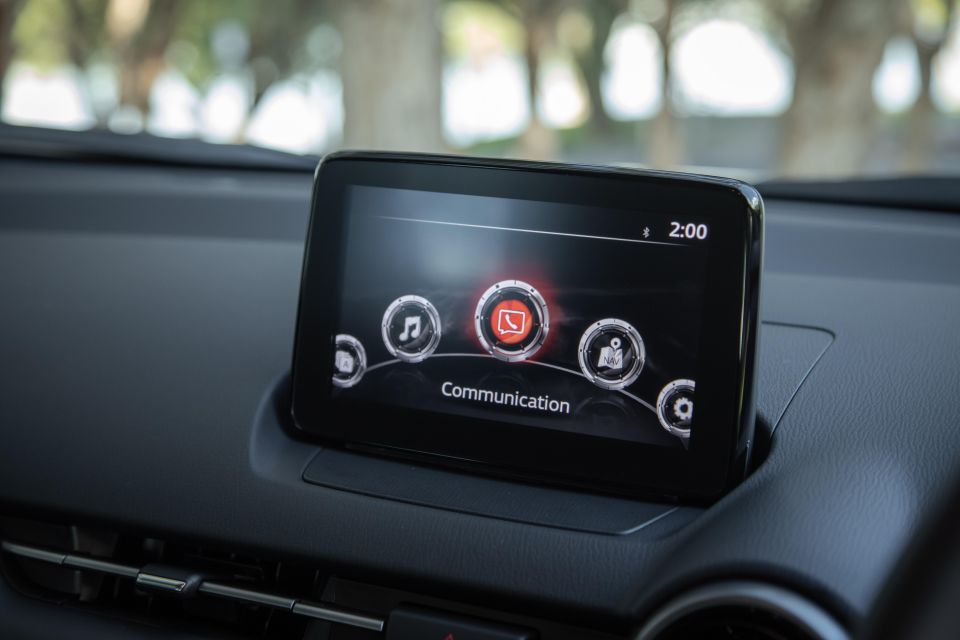
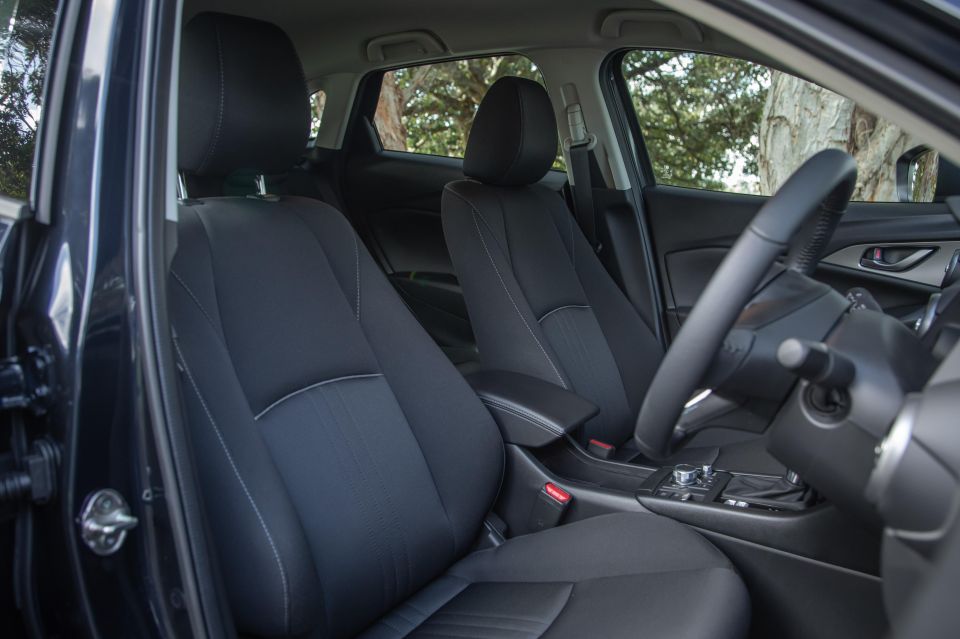
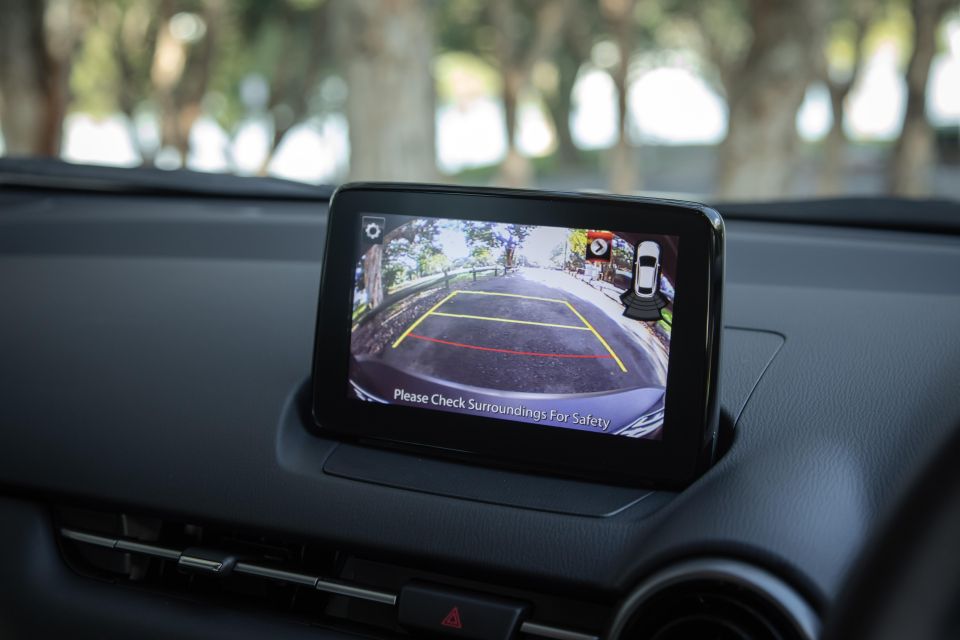
It’s not a happy marriage, though. Navigating a touchscreen-type smartphone format and app functionality using a ‘remote’ dial and buttons is clumsy and distracting. Particularly on the move, where any infotainment touchscreen access is locked out.
Unlike Mazda’s newer display-only hardware you can at least access touch control parked up, though the CX-3’s older content remains clunkier than the slicker and simpler design many other of the company’s model ranges have now moved to.
It feels solid and well put together, with decent materials and a nice feel to the switchgear and controls. But because it’s all minted in uniform grey the ambience doesn’t deliver the sort of pleasing effect you otherwise get in the more colourful and pricier LE version. Storage is okay if unremarkable, including a short phone tray, a weird and almost hidden cupholder array and fairly large bins in the front doors.
The instrumentation design remains neat and sporty, the central analogue speedo a sort of anchor point for driver, though the monochromic LCD screens flanking it and lack of digital speedo drags it all down-market.
The seating is fine, with generally decent comfort if a little overly soft in support, particularly in the seat base wings. If feels compact if thankfully not to point of claustrophobia, at least for those occupying the front row.
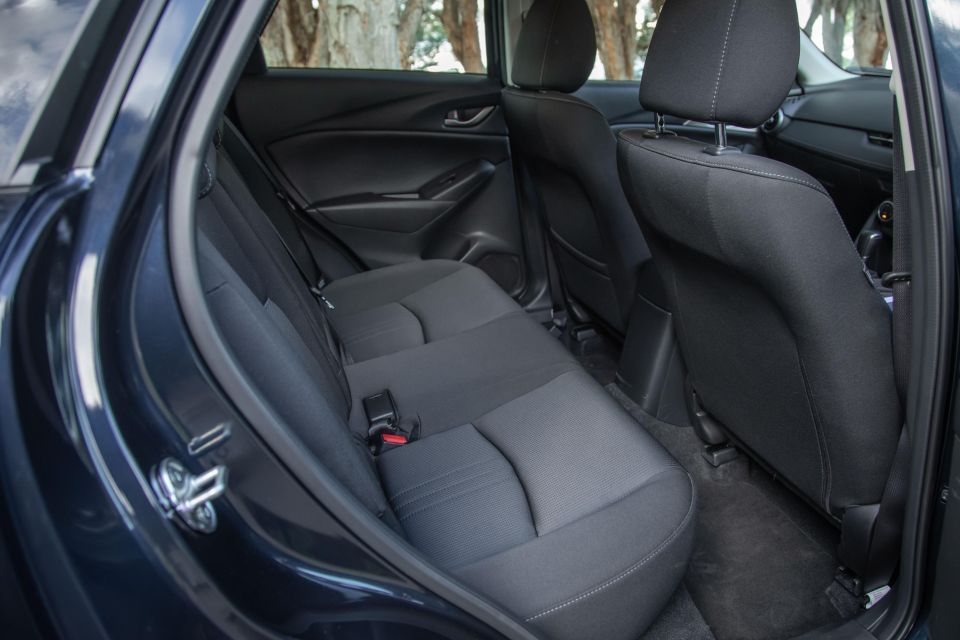
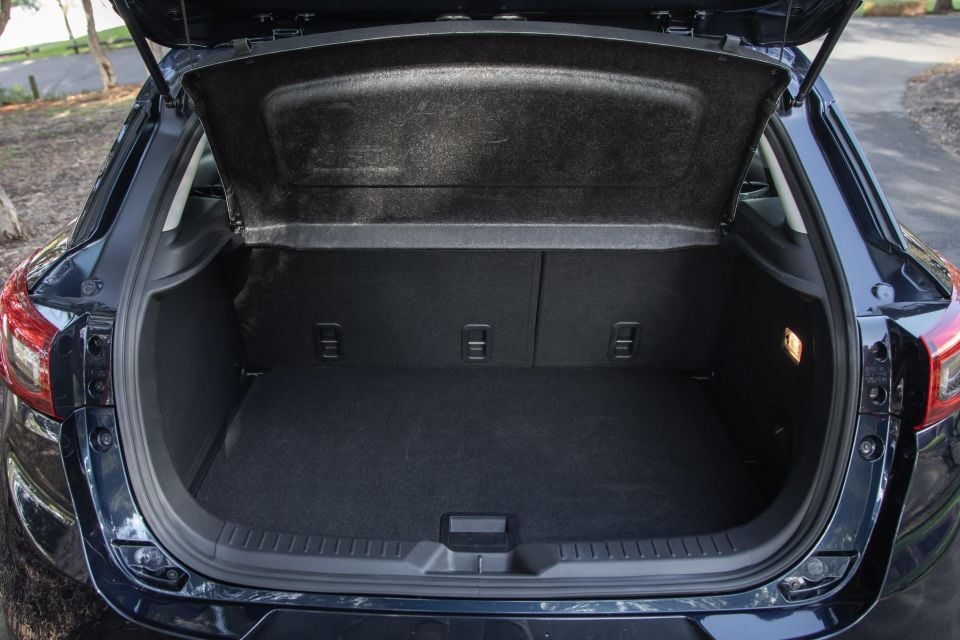
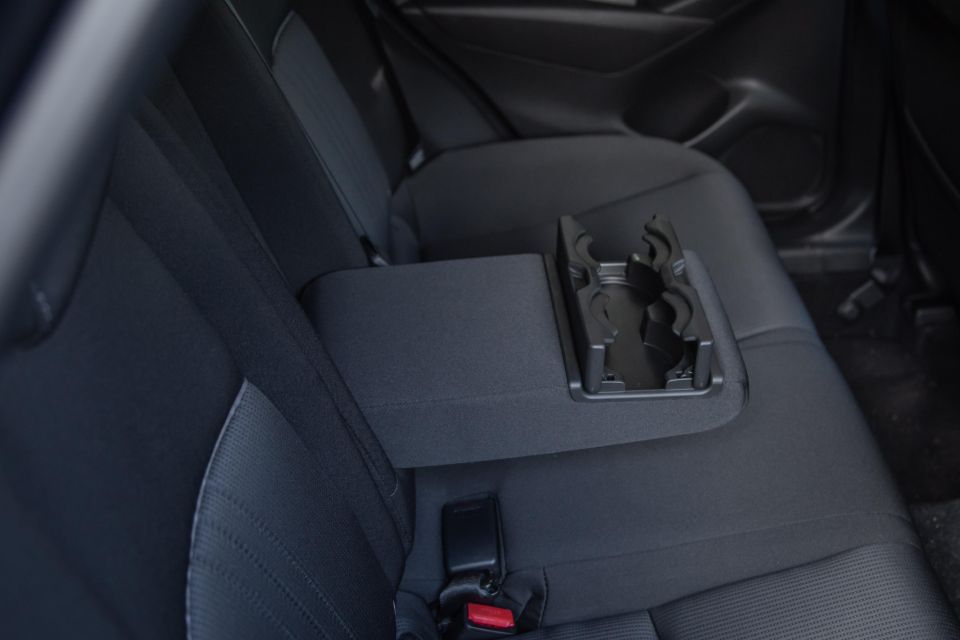
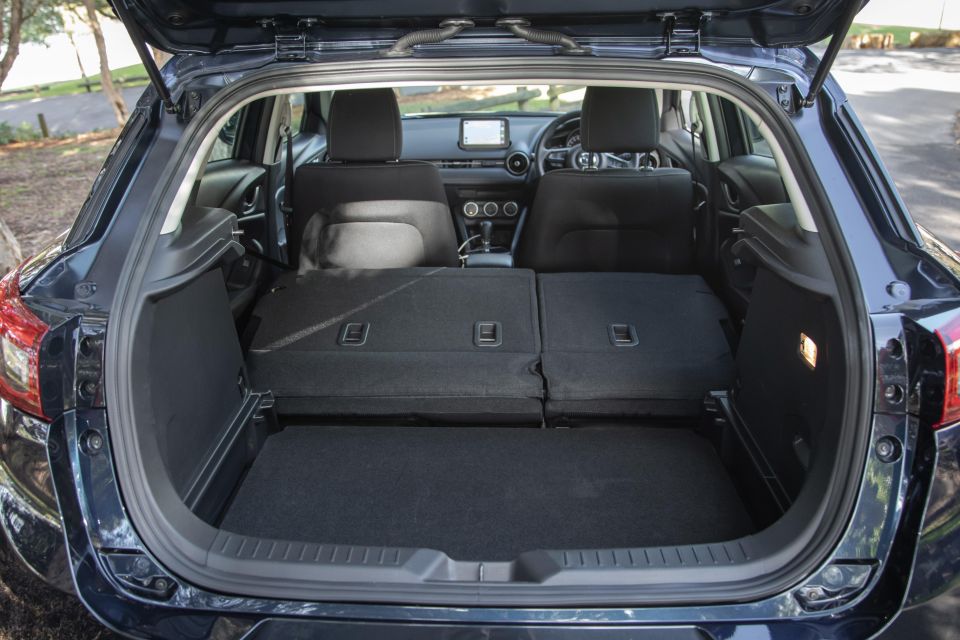
Row two is cramped for adults, with precious little legroom forcing a sort of upright seating posture that gets tiresome for any decent amount of seat time.
It really is solely kid-friendly accommodation in back, though the upswept window line doesn’t allow much outward visibility for smaller children. On that, the Mazda does provide the usual array of ISOFIX and tether anchor points, but the lack of air ventilation and device power are both sizeable markdowns for anything tending towards family friendliness.
Real estate is also at a premium in the boot which, at 264 litres, is small by any measure, including its competition, and really limits loading to groceries and the like. If you really need to lug around the addenda for babies and toddlers, the CX-3 isn’t the ideal solution.
As a city runabout, though, its handy flat-loading 1174L of space is handy if treated as a two-seater with the rear 60:40-split seatbacks stowed.
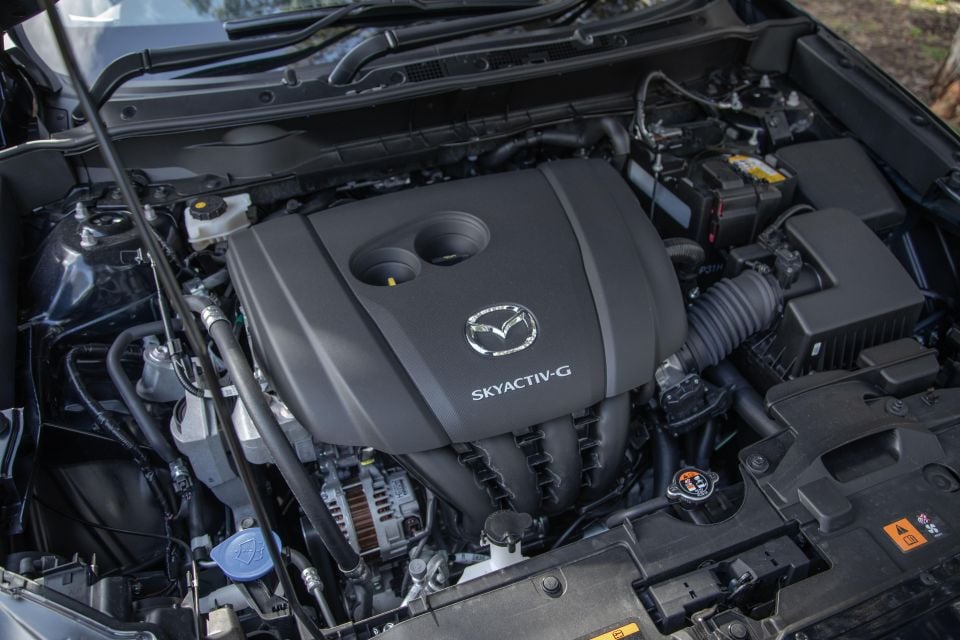
It’s one-size-fits-all when it comes to CX-3 motivation, the entire range powered by the Skyactiv-G 2.0-litre naturally-aspirated four-cylinder engine that produces 110kW at 6000rpm and 195Nm at 2850rpm.
As mentioned above, there’s a choice of transmission types, at least in the FWD format, of a six-speed manual gearbox or a six-speed conventional automatic. Again, AWD variants are auto only.
The front-driven auto version of the CX-3 are the more frugal on claimed fuel usage, bringing a 6.3L/100km claim against 6.6L for the manual equivalent and 6.7L for the all-paw autos. Each fits Mazda’s i-Stop stop/start functionality.
During our time with the CX-3, mostly urban driving if in relatively light traffic that’s hand in hand with ‘unprecedented times’. Our test example tended to hover around the high-seven-litre mark and, typical of natural aspiration, there wasn’t a large fluctuation in thirst when treated to different levels of driving enthusiasm. It runs happily on regular 91 RON in its modest 48-litre tank, too.

Is the front-driven CX-3 any lesser runabout for the lack of all-wheel drive? Realistically, no.
There’s nothing any more adventurous in this chassis and handling package than a Mazda 2 and given it’s not any better suited to multi-terrain activity any on-demand AWD for this or any other road-focused SUV is largely superfluous.
If you regularly traverse well-graded broken surfaces then there might be justification to lean towards four-tyre traction, but for even slightly enthusiastic off-road transit the little Mazda – lower-riding than its styling suggests – will get caught out sooner rather than later.
For urbanites, stick with the FWD version and bank the benefit in upfront price and cheaper running cost via improved fuel consumption.
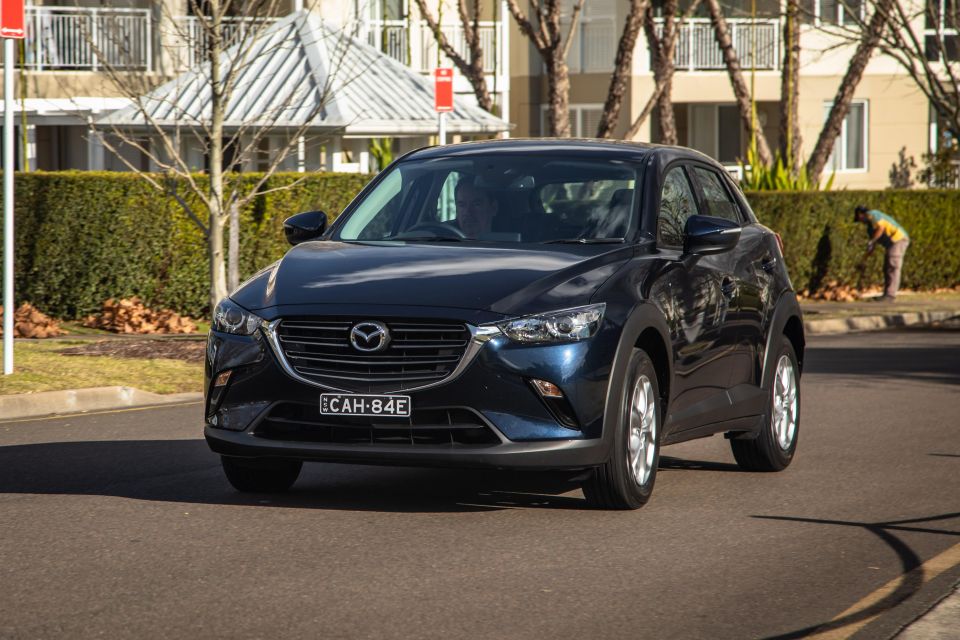
One long-standing hallmark of the CX-3 is its pleasing chassis if one harnessed by a fairly humdrum naturally-aspirated petrol engine.
The 2.0-litre four is responsive enough off the mark, but there’s an absence of genuine shove in the mid-range despite its willingness to pile lots of rpm on.
It’s not that it’s unwilling to get a hustle on if you dig in, it’s just that the engine creates such a ruckus under load that it simply dissuades you from doing so.
And while there’s enough on tap for leisurely punting around the suburbs, there’s none of that unflustered shove you get from turbocharging, as fitted to some of the Mazda’s key rivals.
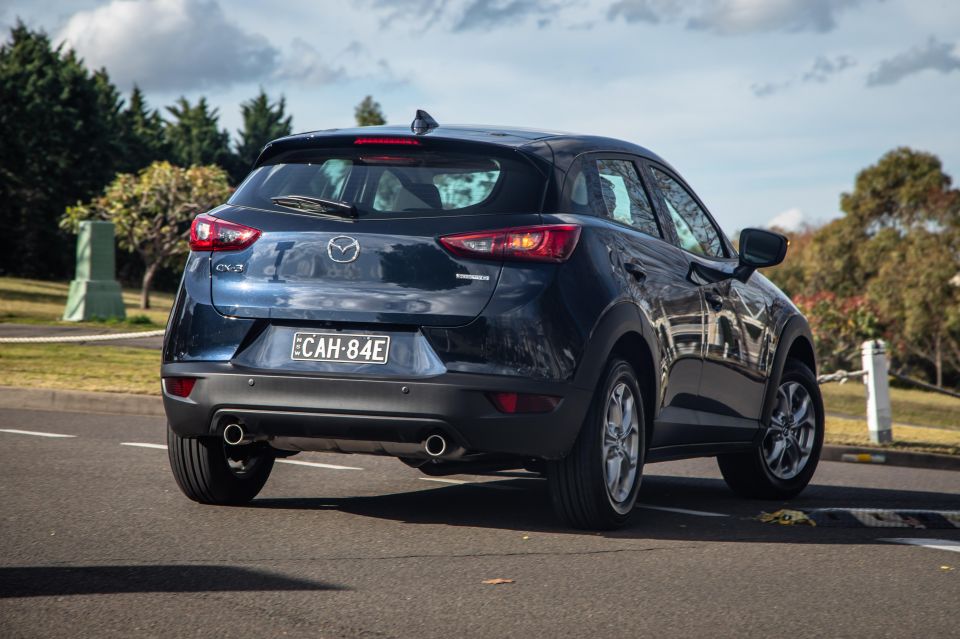
In fact, it’s surprisingly gruff even at a cruise, an ever-present and intrusive whirl from the powertrain putting the dampener on efforts of on-road refinement. As we’ve noted in reviews past, it also whips up extraneous noise at a cold start.
It’s beaut that Mazda opts for a proper conventional automatic rather than a CVT transmission, though it’s not uncommon or unusual given that latter pairs so frustratingly with natural aspiration. It’s generally a good auto, too, save for a shunt in upshifts that’s faint if noticeable enough to annoy.
It’s a shame, because the chassis and somewhat spirited handling deserves better. It might appear jacked up in ride height – a visual trick of the plastic guard trim – but the CX-3 is quite planted on its suspension, which has a tune that’s taut and brings a nice, crisp edge to the driving character and, should you push on, its dynamics.
The rubber fitted mightn’t bring with it a huge amount of grip, but the large sidewalls do add an extra sheen of compliance to ride quality that slightly firm but generally quite pleasant. If there’s a glaring markdown here, it’s that the suspension itself can tend to clunk a little when negotiating speed humps.
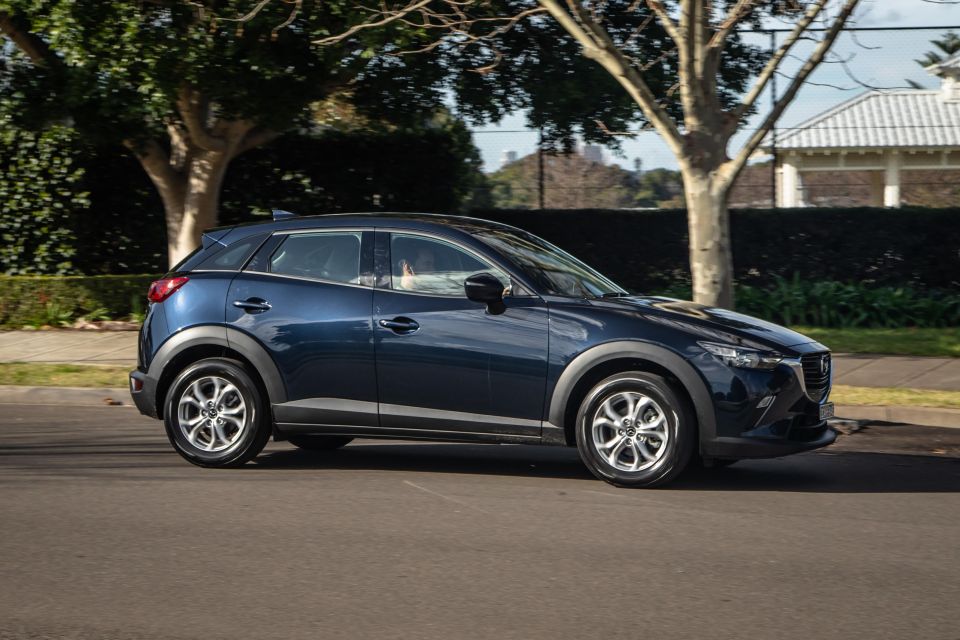
Where expert car reviews meet expert car buying – CarExpert gives you trusted advice, personalised service and real savings on your next new car.
Its pleasing on-road manner makes for what is, on balance, a fairly satisfying urban runabout, particularly one-up. Start loading the Mazda up with loved ones and luggage and it begin to struggle, or at least seems to move Heaven and Earth in its general manner. Really, it begs for a better engine with more of a turbocharged hit to inject a bit more effortlessness and enjoyment.
Where it tends to calm down the most is out on the open road, where it finds its most refined best, though it can get a touch ‘tinny’ and is prone to quite a bit of tyre rumble across less than completely smooth surfaces. Overtaking on the move demands some patience and whole lot of right foot, but it tracks well and feels impressively planted for its small stature and short wheelbase.
Unsurprisingly, its scant stature makes it a doddle to manoeuvre in tight spaces and to park. It’s not hamstrung much by the lack of front parking sensors and the reversing camera, while small in view, is decent enough to remain a handy ally.
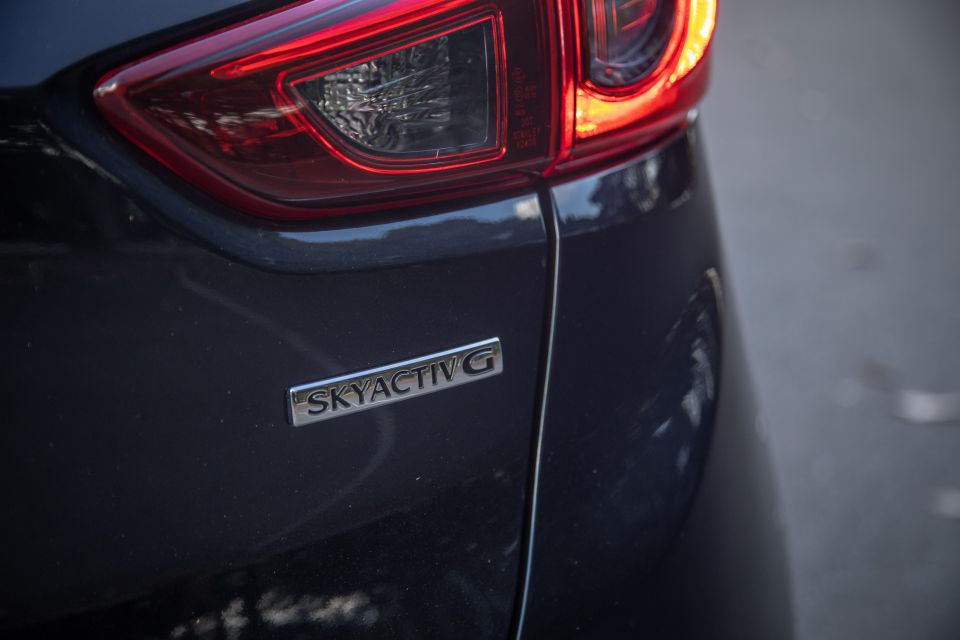
The CX-3 is covered by Mazda’s five-year, unlimited-kilometre warranty with roadside assistance.
Servicing is every 12 months or an unusually short 10,000 kilometres. Not ideal if you’re planning on clocking up the kays and when many rivals have friendlier 15,000km intervals.
Capped-price service pricing alternates between $331 and $391 for the first five visits, or $1775 across 60 months and 50,000kms.
That’s a bit pricier than some key competition, the premium outlay compounded by the fact the same rivals’ makers ostensibly cover servicing through to 75,000kms for the same five-year timeframe.
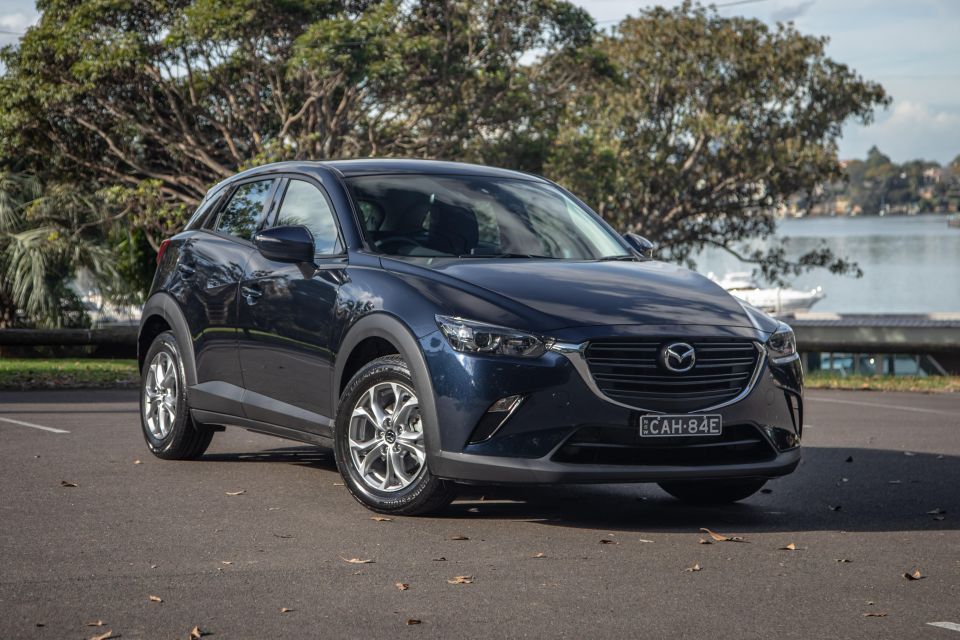
The CX-3 in Maxx Sport FWD guise looks good, offers a great chassis and is priced about right for what it bundles in, as it and its breed have done for quite some time now.
The range has been treated to periodic updates and one mild facelift as it goes through its motions reacting to a segment of ever smarter, more practical, fresher and techier competition.
For its most recent update, highlighted with upgrading an ageing infotainment system to smartphone mirroring capability – with mixed results – in Maxx Sport, specifically, could be easily viewed as too little change this far into the broader range’s advancing lifecycle. And that view doesn’t get any rosier measured up against Mazda’s own CX-30.
However, the critical lens is no filter for the compact SUV’s resilient popularity with buyers. No pressing reasons, then, to meddle much with what remains a successful formula just yet.
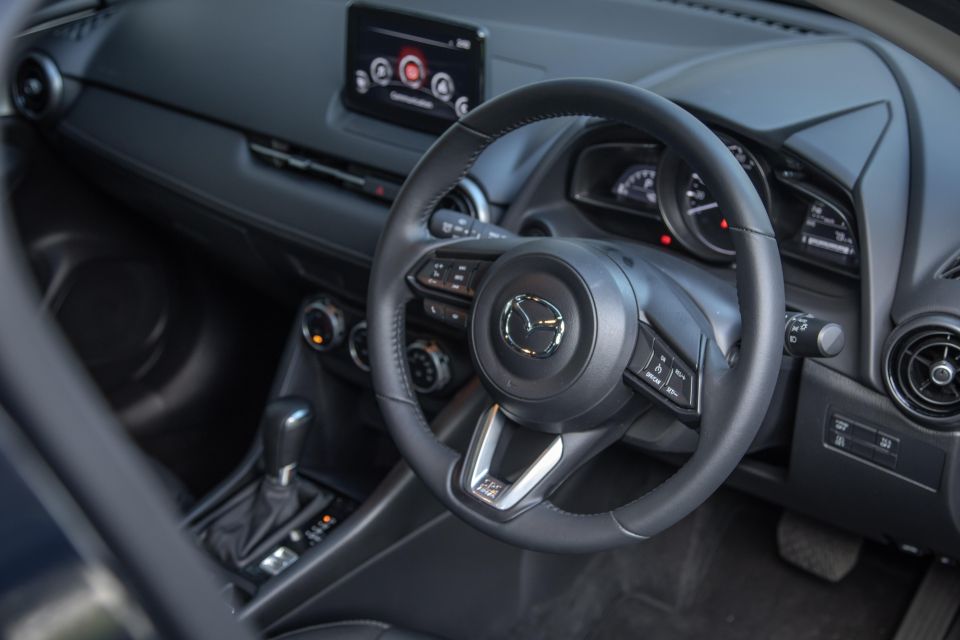
Click the images for the full gallery
MORE: Everything Mazda CX-3
Where expert car reviews meet expert car buying – CarExpert gives you trusted advice, personalised service and real savings on your next new car.


Matt Campbell
5 Days Ago


James Wong
4 Days Ago


Max Davies
3 Days Ago


Josh Nevett
2 Days Ago


Josh Nevett
1 Day Ago


William Stopford
19 Hours Ago